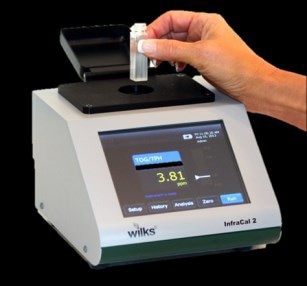In any offshore facility, it is important to monitor oil in produced water because any sheen around the platform can attract costly fines for surpassing the discharge permit limits for oil (Figure 1).
In order to overcome this issue, onboard oil in water analyzers are needed to make sure that oil/water separation solutions are working properly prior to disposing the produced water.

Figure 1. An offshore facility
Inline Continuous Monitoring Systems
Bench top analyzers are generally used to test oil in water, though inline continuous monitoring solutions are being used on a large number of platforms. The inline system provides useful information to platform operators about the waste stream and sends an instant alert if there is any disruption.
The bench top analyzers, on the other hand, are required to confirm if the alert is justified. Although both UV and infrared fluorescence analyzers are widely utilized for bench top testing, infrared offers an additional benefit.
Particle analysis and UV fluorescence technologies are widely used for continuous testing. For particle analysis, video microscopes employ images of droplets and particles with sophisticated algorithms to isolate oil droplets from other particles for a quantitative measurement of oil concentration. With UV fluorescence, aromatic hydrocarbon molecules are excited by ultraviolet light and the intensity of the produced light is correlated to oil concentration.
Inline and Offline Technologies
Both the inline and offline technologies have their own advantages and disadvantages. While UV fluorescence can determine oil directly in water without any need for sample preparation, it can only calculate the aromatic hydrocarbons.
Produced water has a mixture of aliphatic aromatic hydrocarbons. If this ratio alters, UV fluorescence will give an inaccurate reading unless the system is recalibrated. This in turn would lead to an increase of oil content in the produced water which is not detected by UV fluorescence and potentially crosses the permit limit.
Since water absorbs infrared light, it is necessary to separate the oil from the water for testing. This can be done by using a solvent. Therefore, infrared technology is not suitable for inline analysis, but unlike UV fluorescence, it calculates the CH stretch frequency in all hydrocarbons including aliphatic and aromatic hydrocarbons.
Consequently, a component change in the waste stream will not have a major impact on the precision of the infrared measurement results. As a result, combining an offline infrared analyzer with an inline UV fluorescence system would send an instant alert to the platform operator, with a backup infrared process for confirmation and day to day testing.
However, with inline systems, the sample window has to be kept clean because, without clean windows, both particle analysis and UV fluorescence will give incorrect results. If offshore operators fail to follow the cleaning procedures and continue to see inaccurate readings, then the overall confidence in the system will reduce. This becomes a vicious cycle as there is no reason to make an effort on maintenance if the readings turn out to be invalid. Therefore, operator effort is necessary to ensure that the inline measurement system is functioning properly.
This is another reason why grab sample testing on bench top oil in water analyzers is essential to validate the concentration of oil in the treated wastewater. Although continuous monitoring provides useful trend data to solve issues with oil separation systems, grab samples examined on bench top infrared systems such as the InfraCal oil in water analyzer (Figure 1) is important for day to day cross verification testing and also for determining whether the inline system is working properly.

Figure 2. InfraCal 2 oil in water analyzer
Conclusion
The InfraCal oil in water analyzer provides a suitable solution for monitoring oil concentration in the produced water. This not only facilitates day-to-day cross validation testing, but also helps in monitoring the operation of the inline system. Due to this reason, infrared analyzers are frequently utilized on offshore oil platforms to protect against potentially expensive sheens.

This information has been sourced, reviewed and adapted from materials provided by AMETEK Spectro Scientific.
For more information on this source, please visit AMETEK Spectro Scientific.